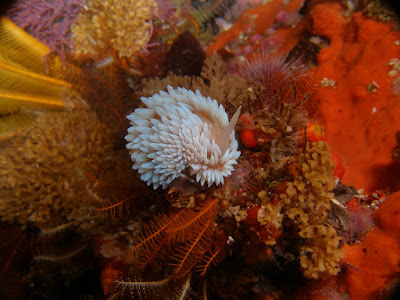 |
| Image: Graeme Kruger Bonisa nakaza |
Now all we need are some water-resistant hot dogs.
 |
| Image: Peter Southwood |
Gasflame Nudibranches typically reach up to 8 cm (3.2 in) long, occasionally as much as 12 cm (5 in), and they're covered in tentacle-like cerata adorned in gas-fire blues and yellows.
 |
| Image: Wilhelm |
 |
| Image: Wilhelm A pair of Gasflames wonder what their babies will look like |
It must make it terribly awkward at nudibranch dinner parties. Imagine being the only one who hasn't got food sloshing up to the tips of your cerata. Surely that would be seen as extremely rude in polite, sea slug society, like not burping in all those places where it's polite to burp after a meal.
Video: Victor Barnard
Gasflame Nudibranches were only described as recently as 1981. Before that I guess people overlooked it because they thought some diver left an oven on. But then microwaves came along and it seemed odd to find an old gas fire in the sea. Perhaps even now there's a Microwave Oven Nudibranch just waiting to be discovered.
 |
| Image: Peter Southwood |
The specific name, nakaza, is a Zulu word meaning "to adorn with beautiful colours". That's a lovely one for Bonnie. Hopefully any unknown Bonisa species discovered in future will be just as lovely. There's always the risk they'll discover one that simply has to get named after the fact that it looks just like a sexual organ or simply must be named after its particularly odd reproductive strategy.
 |
| Image: AndyT |
So no water-resistant hot dogs just yet, but it appears our camp fire creates its very own water-resistant meatballs!

3 comments:
they are really cool and pretty, until i got to the last pic. that was a bit weird. like cotton candy gone wrong.
Any chance of the epomis beetle making it in?
@TexWisGirl: Ha, yeah. Although I'm sure there's a market for cotton candy meatballs somewhere!
@Bk Jeong: Those gruesome customers. Yeah, I'll see what I can find!
Post a Comment